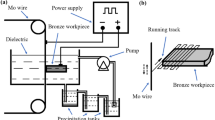Abstract
Dry milling experiments were conducted using five types of milling inserts with various groove profiles in order to investigate the dust distribution characteristics during the dry milling process. Firstly, the experimental scheme and testing system were designed. Secondly, dry milling experiments were carried out based upon orthogonal and single factor experimental methods, and the experimental data was collected. Next, the experimental results were analyzed, and the influence rule and action mechanism of insert geometrical parameters and milling factors on the dust concentration during the dry milling process were studied with the goal of targeting the profiles of inserts that produced less dust. MATLAB was used to interpolate and simulate the experimental data so as to further investigate the spatial distribution characteristics of dust particles around the machine tool. Finally, a dust capacity prediction model was established and validated. Our research findings will aid in improving the environmental quality of dry milling using inserts with complex groove profiles as well as provide theoretical and experimental basis for an in-depth study on the development technology of groove profiles.
Similar content being viewed by others
References
Jiang ZG, Zhang H, Sutherland JW (2012) Development of an environmental performance assessment method for manufacturing process plans. Int J Adv Manuf Technol 58(5–8):783–790
Young P, Byrne CM (1997) Manufacturing and the environment. Int J Adv Manuf Technol 13(7):488–493
Munoz AA, Sheng P (1995) An analytical approach for determining the environmental impact of machining processes. J Mater Process Tech 53:736–758
Durham DR (2002) Environmentally benign manufacturing: current practice and future trends. J Min Met Mater Soc 54(5):34–37
Ratnasingam J, Scholz F, Natthondan V (2009) Minimizing dust emission during routing operation of rubberwood. Eur J Wood Prod 67(3):363–364
Rautio S, Hynynen P, Welling I, Hemmilä P, Usenius A, Närhi P (2007) Modelling of airborne dust emissions in CNC MDF milling. Holz Roh Werkst 65(5):335–341
Khettabi R, Songmene V (2009) Particle emission during orthogonal and oblique cutting. J Adv Mach Form Oper 1(1):1–9
Khettabi R, Songmene V (2008) Understanding the formation of nano and micro particles during metal cutting. J Mater Eng Perform 1(3):203–210
Ren F (2010) Study on Process Planning Technologies for Green Manufacturing. Dissertation, Chongqing University
Choi JP, Lee SJ (2001) Efficient chip breaker design by predicting the chip breaking performance. Int J Adv Manuf Technol 17(7):489–497
Woon KS, Rahman M (2010) The effect of tool edge radius on the chip formation behavior of tool-based micromachining. Int J Adv Manuf Technol 50(9–12):961–977
Khettabi R, Songmene V, Masounave J (2010) Effects of speeds, materials, and tool rake angles on metallic particle emission during orthogonal cutting. J Mater Eng Perform 19(6):767–775
Khettabi R, Songmene V, Masounave J (2007) Effect of tool lead angle and chip formation mode on dust emission in dry cutting. J Mater Process Tech 194(1–3):100–109
Qu SG, Sun FJ, Zhang L, Li XQ (2014) Effects of cutting parameters on dry cutting of aluminum bronze alloy. Int J Adv Manuf Technol 70(1–4):669–678
Li JC, Geng P, Shen JJ (2004) Numerical simulation and experimental investigation of multistage incremental sheet forming. Int J Adv Manuf Technol 68(9–12):2637–2644
Ren F, Liu F (2010) Experimental study on characteristics of spatial distribution of airborne dust in machining. Chin Mech Eng 21(15):1849–1854
Khettabi R, Songmene V, Zaghbani I, Masounave J (2010) Modeling of particle emission during dry orthogonal cutting. J Mater Eng Perform 19(6):776–789
Xie JQ, Bayoumi AE, Zbib HM (1996) Study on shear banding in chip formation of orthogonal machining. Inter J Mach Tools Manuf 36(7):835–847
Xie JQ, Bayoumi AE, Zbib HM (1995) Analytical and experimental study of shear localization in chip formation in orthogonal machining. J Mater Eng Perform 4(1):32–39
Zaghbani I, Songmene V, Khettabi R (2009) Fine and ultrafine particle characterization and modeling in high-speed milling of 6061-T6 Aluminum Alloy. J Mater Eng Perform 18(1):38–48
Author information
Authors and Affiliations
Corresponding author
Rights and permissions
About this article
Cite this article
Cheng, Y., Liu, L., Wang, H. et al. Investigations on the dust distribution characteristics of dry milling using inserts with various groove profiles. Int J Adv Manuf Technol 74, 551–562 (2014). https://doi.org/10.1007/s00170-014-6019-9
Received:
Accepted:
Published:
Issue Date:
DOI: https://doi.org/10.1007/s00170-014-6019-9




